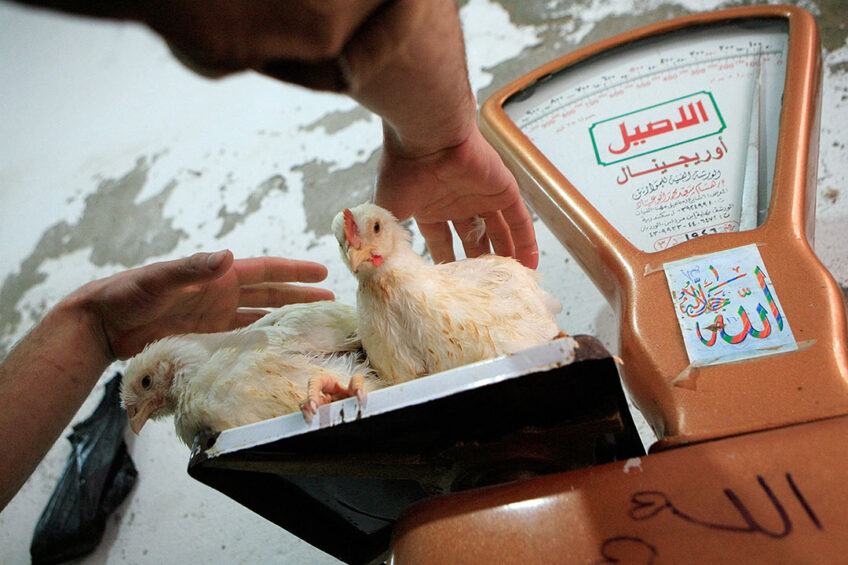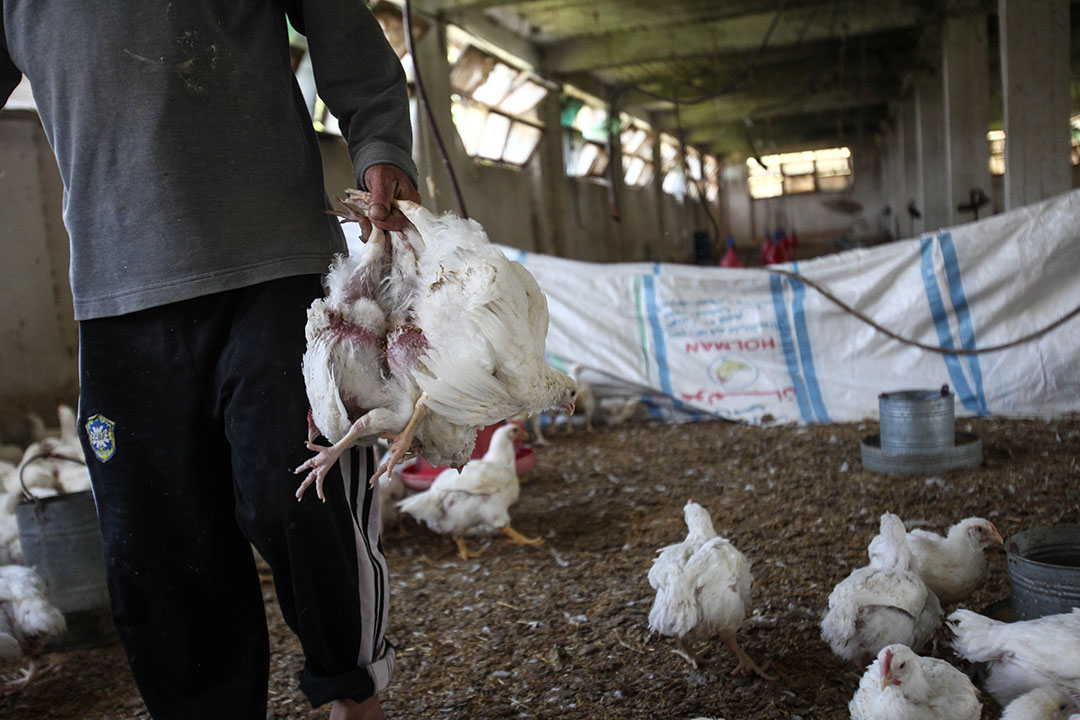North Africa faces poultry production crisis

Footage showing the mass culling of chicks at multiple poultry farms has triggered an outcry among the Egyptian population, many of whom have to count the cost of calories in their diet to make ends meet. Fears are that the poultry industry in North Africa is being more severely impacted by the food crisis further to the disruption of Ukrainian grain exports and other challenges.
Hashtag ‘chicken execution’ went viral in Egypt in October, shortly after a series of videos picturing the brutal slaughter of chicks were posted on social media channels. In the video, a group of men, supposedly workers at poultry farms, put dozens of young chicks into large plastic bags and sealed them, slowly suffocating the birds. The shocking videos are believed to expose only the tip of the iceberg, as poultry culls have reportedly been taking place for months.
Tharwat Al-Zeini, vice president of the Egyptian Federation of Poultry Producers, stated that poultry producers have resorted to culling young chicks due to skyrocketing feed prices, with no certainty that feed would be available in the required quantities in the months ahead.
In an interview with the local press, Al-Zeini admitted that nobody knows how many birds have been culled since the beginning of the crisis. He states that Egypt produces around four million chicks a day, and the recent losses are believed to be estimated in thousands, so in terms of the bigger picture, these culls are not seen as a catastrophe for the industry.
Broader crisis
Poultry farmers are not the only producers suffering in North Africa. Noureddine Ben Ayad, head of the Tunisian Federation of Agriculture and Fishing, warned that the feed crisis has affected several livestock segments in 2022, but poultry and milk farmers had found themselves worst hit. Farmers in the dairy industry, he estimated, had also turned to mass culling.
The Tunisian dairy herd shrank by 25% in slightly more than a year. Culls have reportedly also been seen in the broiler segment, although not on a massive scale. Sometimes poultry farmers slaughter chicks to mitigate rising costs in a bid to weather the storm. However, in other cases it means that farmers have simply given up on their operations.
A number of poultry breeders ceased operating in Morocco over the past year and more will follow as businesses suffer losses and no longer have the resources to bear high costs, says Muhammad Abboud, of the Moroccan National Association of Broiler Breeders.
Too soon to panic
Egyptian officials insist that the October-November culls were an extraordinary measure provoked by a dollar shortage in the country. This had resulted in an unprecedented situation in which around 1.5 million tonnes of corn and 500,000 tonnes of soybeans were stuck at seaports, failing to pass customs clearance. This blockage temporarily suspended service in nearly 80% of mills and sent feedstuff prices soaring.
In November, the Egyptian Ministry of Agriculture agreed to release “appropriate quantities of feed grain” from the seaports every week, primarily to aid poultry farmers. This step cooled the market, although prices are still far from the levels that Egyptian poultry farmers would describe as comfortable.
The idea that the situation in the Egyptian poultry industry is not bad as it seems was supported by Al-Sayyid Al-Qaseer, the Egyptian Minister of Agriculture, who dismissed reports about the mass culling of chicks at poultry farms across the country, attributing the published footage to “individual actions by some poultry breeders”.
Al-Qaseer also warned against exaggerating the issue, raising concerns over “people who deliberately spread panic among the population”. However, Egyptian poultry producers believe that the outlook for the industry is grim. Al-Zeini warned that the current crisis, if left unchecked, would lead to nothing less than the cessation of poultry production in the country.
Tunisian farmers, facing similar challenges, also complain that the authorities refuse to acknowledge the dire situation in the industry. In early September, the Tunisian Ministry of Finance stated that the feed crisis, which had wreaked havoc on production in the previous several months, had been successfully tackled. Several government officials supported this claim. However, recent developments suggest that this might not be entirely true.
“Tunisia is experiencing a food crisis that started from the beginning of the Russian-Ukrainian war,” says Noha Al-Mansi, a Tunisian agricultural analyst, who recalled that customers first noticed supply disruptions of sugar, milk, and eggs accompanied by sharp price fluctuations. This list has recently expanded to include vegetables, meat and poultry. In light of this, the authorities are facing criticism for the lack of effort to overcome food supply disruptions.
“The concerned parties stand idly by, contenting themselves with linking the crisis to the Russian-Ukrainian war and global problems,” Al-Mansi says.

Everybody blames everyone else
In Morocco, poultry farmers put the blame for soaring costs on feed mills. In November, the National Association of Broiler Breeders appealed to the government “to put an end to all actions that contradict the rules of competition practised by feed companies, especially with regard to their pricing policies.”
As in other parts of North Africa, Moroccan poultry producers are highly dependent on feedstuff imports. Muhammad Abboud is confident that the feed price is unjustified given that global grain prices have retreated from the peak levels of recent months owing to the Russia-Ukraine grain deal which paved the way for Ukrainian grain exports to resume.
In developed countries, such as France, the average cost of growing broilers now stands at 13 dirhams (US$ 1.22) per kg. In Morocco, it ranges between 15.5 and 17 dirhams (US$ 1.45 – US$ 1.59). Abboud also adds that while European farmers pay for good quality feed, the quality of the poulty feed in Morocco leaves a lot to be desired. Quality issues mean that a single broiler in Morocco requires 5 kg of feed to reach slaughter weight, compared to 3.2 kg in developed countries.
Over the past few months, the Moroccan population has been furious about the rising broiler prices, and poultry farmers, in turn, have found themselves under fire. They blamed the market turmoil on feed mill owners who raised the prices for their products in October immediately after the end of the poultry fair in Casablanca “all of them together, with no respect for the rules of competition”, states Abboud.
Moroccan feed producers, however, dismiss these claims about unjustified price increases, in turn laying the blame for the market situation on the grain traders and logistics companies, citing expanding shipping costs among the reasons why the feed is more expensive.
Poultry farmers believe the government regulator should step in to monitor price dynamics and product quality in the feed market. People in low and middle-income countries are more affected by rising food prices than those in high-income countries because they spend a larger percentage of their income on food, the World Bank noted in its recent report, listing both Morocco and Tunisia among the lower-middle income countries.
Grain and water scarcity
All the countries in North Africa depend on imported feed grain. Egypt meets nearly 70% of its domestic demand for yellow corn and soybean through raw material imports from Argentina, Brazil and Ukraine, buying roughly 10 million tonnes of corn and 4.7 million tonnes of soybeans annually. Domestic production stands at 3 million tonnes of corn annually. Feed prices jumped nearly 40% year-on-year in July, reaching 12,000 Egyptian pounds (US$ 487) per tonne.
After a temporary correction in August, the average price began rising again to 13,600 pounds (US$ 553) in November. This year, poultry farmers across the Middle East and North Africa region (MENA) are suffering due to spiralling energy and grain prices. In North Africa these problems have been further aggravated by the logistics crisis, as rising transport costs further drive up prices for imported grain.
In October, the Tunisian government stepped into the feed market – which is subject to state regulation – and approved a rise in the wholesale feed price of 300 dinars (US$ 100) per tonne, or 15 dinars (US$ 50) for a 50 kg bag of feed, the selling price of which thus reached 79.50 dinars (US$ 25.6). The Tunisian Federation of Agriculture and Fisheries issued a statement in response, calling the decision “a fatal bullet for all animal production sectors, including red meat, poultry, egg and milk”.
To make things worse, the current crisis is more than just about the price of feed grain. All the countries in this part of the world suffer from water scarcity which has built up for decades. By 2025, the water supply in Egypt is estimated to drop below 500 m3 per capita, a very low level that hydrologists typically define as ‘absolute scarcity’.
Morocco expects to reach ‘absolute water scarcity’ by 2030 and Tunisia a few years earlier. The worsening water scarcity is attributed to rapid population growth and climate change, among other things, resulting in more hot and dry years. Climate change is harming grain production and brings additional costs to poultry farmers.
Some environmentalists believe that in the long run this could hurt local farmers far more than the current crisis. In light of these challenges, it looks as though poultry farmers in North Africa are going to have to brace themselves for tough times ahead.
 Beheer
Beheer











 WP Admin
WP Admin  Bewerk bericht
Bewerk bericht